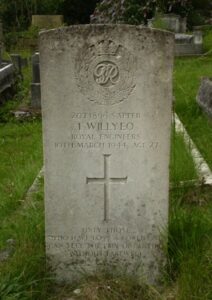Trimsaran is a village in the Gwendraeth Valley, which lies on the B4308 between Llanelli and Kidwelly, six miles from Llanelli, and 13 miles from Carmarthen. The history of the village is closely linked to that of the coal mining industry, which was at its peak at the outbreak of the Great War. The men of Trimsaran who fell during both World Wars are commemorated on the village War Memorial, which is located inside the former Miners Welfare Hall. The WW2 section of the memorial oddly contains the names of one man who was killed after the war, and one before the war, instead of naming them under a separate heading.
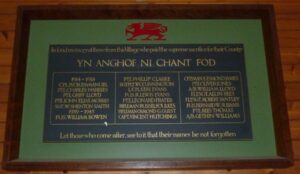
The Great War, 1914-1918
Sidney Cobb, Private, 2219, Leicestershire Yeomanry. Sidney was born at Stevenage in 1886, the son of Sidney Cobb and Anne Cobb (nee Bingham). His father worked as a Gamekeeper, and by 1911 the family was residing at Dunvant, before moving again to Keeper’s Lodge, Trimsaran at some time during the war. Sidney worked as a gamekeeper on the Underwood Estate at Lockerbie prior to enlisting at Melton Mowbray into the 1/1st Battalion, Leicestershire Yeomanry. He landed in France on 25 May 1915 joining the Rutland Troop, ‘A’ Squadron of his battalion, which was attached to the 7th Cavalry Brigade, 3rd Cavalry Division. The battalion was in a rest camp at Hazebrouck when Sidney arrived. The 3rd Cavalry Division was maintained in case of an infantry breakthrough, so stood by ready to charge forward and exploit any gains. Following the closure of the Battle of Loos, which opened on 25 September 1915, the 3rd Cavalry Division remained in the Loos sector over the winter. Sidney was killed on 21 January 1916, the sole man killed of the unit for the entire month. The 30-year-old has no known grave, so is commemorated on the Loos Memorial, France. Sidney is not named on the Trimsaran Memorial, although his parents lived there until their deaths and are buried in Llandyry Church, Trimsaran.
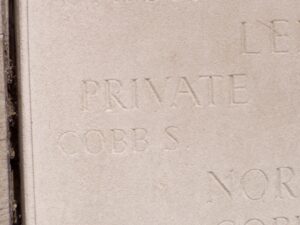
Samuel Ivor Dunn, Private, 32486, Devonshire Regiment. Samuel was born at Trimsaran in 1900, the son of Charles Dunn and Elizabeth Ann Dunn (nee Clarke). By 1901 the family had moved to Sheffield, where his father Charles had found work as a labourer in a steelworks. Samuel enlisted at Sheffield into the Royal Warwickshire Regiment. He was then posted to France, becoming transferred to the 5th Battalion, Devonshire Regiment, which was attached to 185 Brigade, 62nd (2nd West Riding) Division. The Division concentrated on the Western Front by 18 January 1917, and took part in Operations on the Ancre. In March 1917 the Division followed the German Retreat to the Hindenburg Line, and then fought at the Battle of Arras, during the Flanking Operations Round Bullecourt. Later that year saw them in action again at the Battle of Cambrai. On 5 January 1918, the Division took over the front line in the Arras area, between Gavrelle and Oppy, and suffered heavy casualties during the German offensive of 21 March 1918, and was moved to Northern France the following month to rest. When the Germans launched their offensive on the Aisne, the division was among four British divisions sent there to aid the French, and again suffered heavy casualties. The Division then moved back north to the British sector, and took part in the advance to the Hindenburg Line from August 1918 onwards. On 17 September the 5th Devons moved to a rest camp at Beugnatre to rest and train, prior to moving back into the line at Hermies on 26 September, and bivouacked in the trenches. On the following morning, 27 September 1918, as part of the Battle of the Canal Du Nord, the battalion moved across the canal and assaulted Premy Avenue and Kaiser Trench, two strongly defended German positions at Flesquières. Samuel was killed in action during the assault that day. The 18-year-old was buried in Lowrie Cemetery, Havrincourt, France. Samuel is not named on the Trimsaran Memorial.
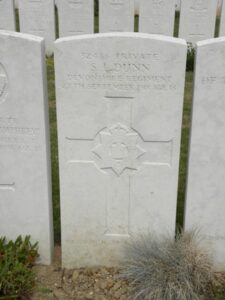
Ivor Emanuel, Lance Corporal, 275, Welsh Guards. Ivor was born in 1892, the son of John Emanuel and Mary Emanuel (nee Treharne), of Morlais Isaf Farm, Trimsaran. He married Prudence Paulfrey Richards, of Brynygraig, Mynyddygarreg in 1915. He worked as an electrician at the Trimsaran Collieries prior to enlisting at Llanelli into the Grenadier Guards, but then transferred into the 1st Battalion, Welsh Guards. The Regiment had been raised by Royal Warrant of 26 February 1915, at White City, before landing at Le Havre on 18 August 1915, becoming attached to 3rd Guards Brigade, Guards Division. The Division saw its first major action during the Battle of Loos, which began on 25 September 1915. During the opening day, the Guards Division began moving into position, watching the terrible scenes in front of them, before launching its own attack on the following morning. At around 18.00 that day the Welsh Guards received orders to attack a feature called Hill 70, and as the men slowly made their way forwards, darkness fell. As soon as the battalion reached the top of the Hill, German machine-gunners opened up a murderous fire on them, forcing the men to dig into the many shell holes littering the crest, before retiring to positions just below of the crest, where the survivors dug-in. Ivor was killed in action at Hill 70 on 27 September 1915. The 23-year-old has no known grave, and so is commemorated on the Loos Memorial, France. His daughter, Ivorine Emanual, served during the Second World War as a Sister with Queen Alexandra’s Imperial Military Nursing Service, whilst his brother Joseph won the Military Medal whilst serving with the Welsh Guards near the end of the war.
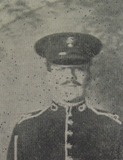
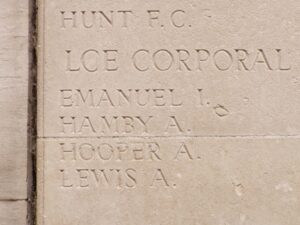
Charles Harries, Private, 17003, Royal Welsh Fusiliers. Charles was born in 1888, the son of David Harries and Elizabeth Harries, of Rosehill, Waunyclyn, Trimsaran. He worked as a collier prior to enlisting at Ferndale on 2 September 1914 into the South Wales Borderers, but within three weeks had been discharged after having been deemed physically unfit for service, as he had no teeth. Undeterred, Charles then re-enlisted, joining the Royal Welsh Fusiliers, and was posted to France on 2 February 1915, joining the 1st Battalion, Royal Welsh Fusiliers, which was in Flanders attached to 22 Brigade, 7th Division. On 10 March 1915 the 7th Division took part in the disastrous Battle of Neuve Chapelle, which lasted three days for little or no gain. The 1st RWF then moved to billets at Fort D’Esquin, where it enjoyed several weeks rest behind the lines. By 7 April the 1st RWF had moved to reserve billets at Rue du Bacquerot, and four days later relieved the Royal Scots in the trenches to begin a routine tour in the line, being relieved on 14 April. The battalion enjoyed another period out of the line until 6 May, when it moved forwards again, to take part in the Battle of Aubers Ridge, where the Division launched an assault against the village of Aubers on 9 May 1915. The 1st RWF remained in the assembly trenches, in support of the assault, but the attacking troops made no gains, so the battalion was not called upon, and marched to billets in Essars. On 15 May 1915 the 7th Division took part in another assault, against the village of Festubert. The 1st RWF moved from its billets at Essars that day, marching via Bethune to its starting positions at Rue Cailloux, and at dawn on 16 May 1915 launched its assault on the German lines opposite, ordered to seize the line running from the Rue Quinque to Rue D’Ouvert. The battalion swept through the German front and 2nd lines, before becoming held up, suffering very heavy casualties. Charles survived the battle, but was killed in action on 21 May 1915, just before the battalion was relieved. The 27-year-old has no known grave, so is commemorated on the Le Touret Memorial, Richebourg L’Avoue, France.
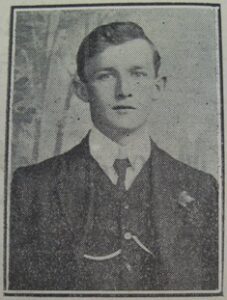
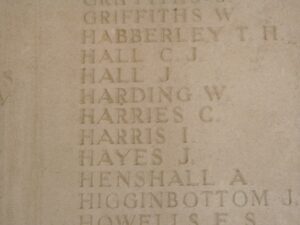
Griffith Lloyd, Private, 307171, Lancashire Fusiliers. Griffith was born in Cileen, Flintshire in 1884, the son of Pryce Lloyd and Ellen Lloyd (nee Hughes). Griffith and his father were Gamekeepers and had held positions at Manordeifi before moving to the Keeper’s Lodge, Trimsaran prior to the war. Griffith enlisted at Kidwelly into the army and upon being drafted to France, was posted to the 2/8th Battalion, Lancashire Fusiliers, which was attached to 197 Brigade, 66th (2nd East Lancs.) Division. The Division concentrated on the Western Front by 16 March 1917, and moved to the Flanders Coast for trench initiation. At the end of September 1917 the division moved to Ypres, and took part in the Battle of Poelcapelle. Upon being relieved in the middle of November, the division moved out of the line to the Berthen area, before embussing for Staple and did not go back into the line until the end of the year, taking over positions northeast of Zonnebeke. In February 1918 the division was relieved again and entrained for Amiens, before taking up positions in the Somme sector. On 21 March 1918 the division was hit hard by the German Spring Offensive and saw heavy fighting as it withdrew over the Somme Crossings. Griffith was wounded during this terrible time, and died of his wounds on 28 March 1918. The 28-year-old is buried in Namps-Au-Val British Cemetery, France.
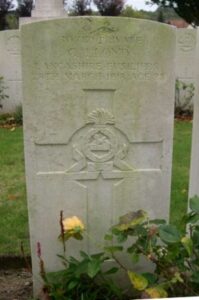
John Elias Morris, Private, 80265, Welsh Regiment. John was born in 1899, the son of David Morris and Mary Morris (nee Rees), of Bryn Golen, Waun-y-clyn, Trimsaran. He enlisted at Carmarthen into the Monmouthshire Regiment, but upon being drafted to France late in 1918, was posted to the 14th Battalion, Welsh Regiment, which was attached to 114 Brigade, 38th (Welsh) Division. The Division had been in France since December 1915, and had fought at Mametz Wood the following year, then at Ypres in 1917. The division then spent several months in the Armentieres sector, before moving back to the Somme in April 1918. On 21 August 1918 the division took part in the great offensive, driving across the River Ancre, and rolling back the German lines over the coming days. John would have joined his battalion here at the end of August 1918. Then the move began towards the mighty Hindenburg Line, and the Division carried on with their march east, fighting at the Battle of Havrincourt, and the Battle of Epehy. A short rest period ensued, during which time the Canal du Nord was breached, so opening a passage through the Hindenburg Line. The Division then fought at the Battle of Beaurevoir, and moved up towards Cambrai, capturing Villers-Outreaux, before advancing towards the Forest of Mormal. John was wounded during the Battle of the Sambre, the final days of the war, and died of his wounds at the 3rd Casualty Clearing Station, Caudry on 10 November 1918. The 19-year-old is buried in Caudry British Cemetery, France.
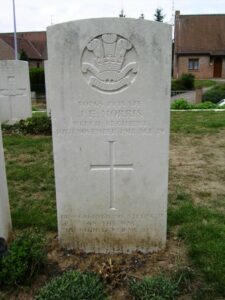
William Leslie Shenton, Acting Sergeant, 18731, Royal Welsh Fusiliers. William was born in Luton, Bedfordshire on 30 July 1898. By 1901 he was living with his Uncle and Aunt, William and Mary Smith, at Leek, Staffordshire, and by 1911 the family lived at Brickmakers Cottage, Trimsaran. William enlisted at Kidwelly into the Royal Welsh Fusiliers soon after the outbreak of war and was posted to the 16th Battalion, Royal Welsh Fusiliers. The battalion was raised at Llandudno by the Welsh National Executive Committee from a cadre from the 13th Battalion, joining 128 Brigade, 43rd (Welsh) Division and began training at Rhyl and Colwyn Bay. On 29 April 1915 the formation became renumbered to 113 Brigade, 38th (Welsh) Division, before moving to Winchester in the summer of 1915 to complete its training. The Division moved to France on 2 December 1915 and moved to the Nursery Sector near Fleurbaix for trench initiation alongside the Guards Division. The Division then held a sector of the line near Cuinchy before marching south to the Somme sector in June 1916 to take part in the assault on Mametz Wood. The first attack on the wood was launched on a two-battalion front on 7 July, but failed, and the Divisional Commander, Sir Ivor Philipps, was replaced before the Division attacked again on a two Brigade front on 10 July 1916. After two days of ferocious hand-to-hand fighting, the wood was cleared up to its northern edge, before the battered Division was relieved. It then took over a section of the front at Hébuterne before moving to the Ypres Salient, and taking over the Canal Bank sector at Boesinghe. The infantry battalions of the Division then began carrying out the normal pattern of rotation in the trenches, four days in the front, four in support and four in reserve, whilst also working on trench improvement, digging new trenches, and also carrying out regular patrols and trench raids. On 31 July 1917 the Division launched its famous assault on the Pilckem Ridge, capturing Iron Cross and reaching its objective of the Steenbeek. William was killed in action here on 31 July 1917. The 19-year-old has no known grave, and is commemorated on the Ypres (Menin Gate) Memorial, Belgium.
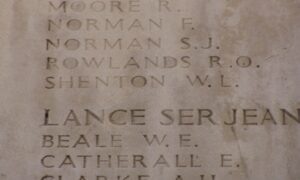
—————————————————————————————————————————————————————————–
World War Two, 1939-1945
William Bowen, Fusilier. This man cannot presently be identified.
Philip Henry Clark, Lance Bombardier, 798263, Royal Artillery. Philip was born at Pontypridd in 1911, the son of Philip Henry Clark and Bessie Hanfer Clark (nee Lamb). His father had served with the Royal Garrison Artillery during the Great War and upon his return from France moved his family to 153, Garden Suburbs, Trimsaran after gaining work there as a colliery railway platelayer. Philip married Gertrude Albenia Vick in Bristol on 27 December 1937, whilst working locally as a labourer. He then followed in his fathers footsteps and enlisted into the Royal Artillery some time prior to the outbreak of the Second World War. Philip was sent out to France with the 68th Field Regiment, Royal Artillery soon after the outbreak of war. The battery was part of the BEF and took up positions on the Belgian frontier. Following the invasion of the low country by German troops in May 1939, the BEF withdrew to the Channel Coast for evacuation. Philip was taken prisoner by the Germans during this tumultuous time and was posted as missing, but was later found to be incarcerated at Stalag XX-B in Malbork, Poland. He was later transferred to Stalag XX-A at Funfeichen, in Germany. Philip died in captivity there on 28 February 1945. The 33-year-old was originally buried in Funfeichen Cemetery, but in May 1949 the Allied war graves within the cemetery were exhumed and re-interred in Berlin 1939-1945 War Cemetery, Germany.
Wilfred Courtney Cunnington, Sergeant, Royal Air Force. Wilfred was born on 8 April 1909, the son of George Snodin Cunningham and Annie Cunningham (nee Phipps), of 25, New Houses, Trimsaran. He enlisted into the Royal Air Force as a young man and was posted to 148 Squadron, Royal Air Force. The squadron had been disbanded following the end of the Great War, but reformed at RAF Scampton on 7 June 1937, equipped with the Hawker Audax and the Vickers Wellesley medium bomber. On Tuesday 18 October 1938, Wilfred took off from RAF Stradishall, Newmarket aboard a Vickers Wellesley, Serial K7716, which was only the third Wellesley to be given over to the RAF. Sadly soon after take off the Wellesley collided head on with Wellseley K7714, also of 148 Squadron, over Great Dunmow, Essex, killing all three men aboard each aircraft. Wilfred was 29 years old when he was tragically killed that day. His remains were recovered from the wreckage and brought home for burial in Llandyry Churchyard, Trimsaran. Wilfred is not commemorated by the CWGC as he was killed prior to the outbreak of World War Two.
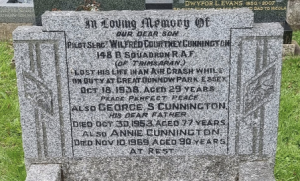
William Dennis Dixon, Sergeant, 1835971, Royal Air Force Volunteer Reserve. William was the son of William and Annie Dixon, of Carway, Carmarthenshire. He enlisted into the Royal Air Force Volunteer Reserve and after completing his training as an Air Gunner was posted to 50 Squadron, Royal Air Force, which was equipped with the Avro Lancaster III, and was based at RAF Skellingthorpe. On 3 May 1944 William took off from Skellingthorpe aboard Lancaster LM480 as part of a detachment from 50 Squadron which had been sent to bomb a German military camp at Mailly-le Camp. The Lancaster was one of four lost during the raid, when it was shot down soon after clearing the target area and crashed near the village of St. Mesmin. Two crewmen escaped but William was among seven men killed in the crash. He was 20 years old and was buried alongside his fellow crew-members in St. Mesmin New Communal Cemetery, France. One of the survivors was captured and interred at Buchenwald, while the second survivor came into contact with a Resistance group and was killed when their camp was attacked by a German patrol on 24 June 1944. William is not commemorated on the Trimsaran Memorial but worshipped in Sardis Chapel.
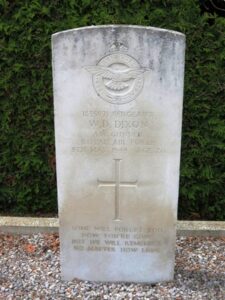
William Samuel Gwyn Edwards, Gunner, 933179, Royal Artillery. William was born in 1918, the son of Thomas Edwards and Lily Edwards (nee Somer), of Trimsaran. He enlisted into the Royal Artillery and was posted to the 9th Field Regiment, Royal Artillery. The regiment was posted to the Far East to join the 20th Indian Division, which was raised in Bangalore on 1 April 1942. The division trained in Ceylon before seeing Active Service in Assam, Burma and Indo China against the Japanese. The Division distinguished itself during the Defence of the Imphal plain, in the spring and summer of 1944. William was badly wounded here and died of his wounds on 11 June 1944. The 26-year-old was buried in Imphal War Cemetery, India. William is not named on the Trimsaran Memorial.
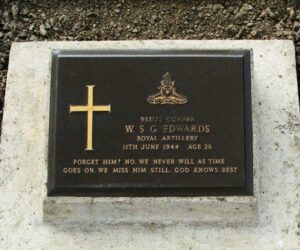
Victor Emanuel, Sergeant, 563099, Royal Air Force. Victor was born in 1913, the son of Thomas Emanuel and Florence Emily Elizabeth Emanuel (nee Cutler), of Morlais Isaf Farm, Trimsaran. His father had moved from the village when he was young to serve with the Royal Marines, and saw action during WW1, however, his uncle, Ivor Emanuel, was killed at Loos in 1915. Victor married Eileen Muriel Hages in Wiltshire in 1938, while based locally with the Royal Air Force. By the outbreak of war he was serving with 61 Squadron, RAF, which was a bomber squadron, equipped with the Handley Page Hampden. The squadron took part in the first bombing raid on a German land target when it bombed Hornum on the night of 19 March 1940. On 15 April 1940, Victor was a crew member of Hampden Mk 1, Serial L4113, which departed from its base at RAF Hemswell to lay mines in the Elbe estuary. The aircraft failed to return, and was presumed lost at sea that night. Victor was 27 years old, and is commemorated alongside his fellow crewmen on the Runnymede Memorial, Surrey. Victor does not seem to be commemorated locally.
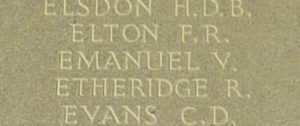
Keri Evans, Lance Corporal, 23343324, Royal Military Police. Keri was born on 6 August 1934, the son of Alwyn Evans and Katherine Muriel Evans (nee Charles), of Maesybryn, Trimsaran. Keri enlisted into the army and joined the Royal Military Police. He was based in Germany when he was killed as the result of a motor accident, when he crashed his Jeep on 20 June 1958. Keri was 23 years old and his body was brought home for burial in Sardis Congregational Chapelyard.
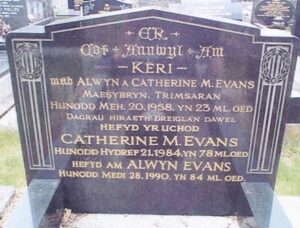
Richard Lewis Evans, Fusilier, 4197438, Royal Welch Fusiliers. Richard was born in 1918, the son of James Evans and Hannah Evans (nee King), of Pont Cottage, Trimsaran. He enlisted into the army and was posted to the 1st Battalion, Royal Welch Fusiliers. The battalion had been in France with the BEF when war broke out and suffered heavy casualties as it withdrew to Dunkirk in May 1940. After rebuilding the battalion was sent to the Far East, taking part in the campaign in India and Burma against the Japanese. The 1st RWF then became embroiled in one of the fiercest campaigns of the entire war, The Battle of Kohima. The battle raged from 4 April to 22 June 1944 around the town of Kohima, in Northeast India. It began when the Japanese attempted to capture Kohima ridge, a feature which dominated the road by which the besieged British and Indian troops of IV Corps at Imphal were supplied, then from 18 April to 13 May British and British Indian reinforcements counter-attacked to drive the Japanese from the positions they had captured. Fighting raged until 22 June when British and British Indian troops from Kohima and Imphal met at Milestone 109, ending the Siege of Imphal. Richard was killed in action at Kohima during the height of the fighting, on 5 May 1944. The 26-year-old was buried in Kohima War Cemetery, Burma.
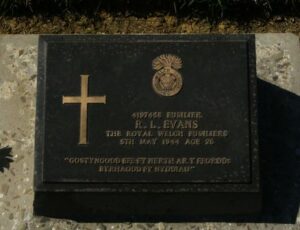
Russell Fokes, Rifleman, 5338931, Rifle Brigade. Russell was born on 7 January 1918, the son of Stanley Theodore Fokes and Florence Fokes (nee Lewis), of 2, Caeduen View, Trimsaran. He worked as a tin shearer in Slough prior to the war and resided at 24, Norfolk Avenue, Slough. Russell enlisted into the army soon after the outbreak of war and was posted to the 1st Battalion, Rifle Brigade. The original battalion was sent to France as part of the 30th Infantry Brigade was lost at the defence of Calais. It was then reformed in England before joining the 2nd Armoured Brigade, 1st Armoured Division and took part in the North African Campaign before transferring to the 22nd Armoured Brigade, 7th Armoured Division in June 1942. The division played an important part in the defeat of the Afrika Korps, who surrendered in May 1943, and then took part in the invasion of mainland Italy before being recalled to England in January 1944 to prepare for the Normandy Landings. Russell landed on the Normandy beaches on 6 June 1944 with his battalion, which proceeded to take part in the fighting to break out from the beach-head. Russell was killed in Normandy during heavy fighting near Falaise on 29 July 1944. The 26-year-old was originally buried in Mondeville, but in September 1945 the scattered war graves in the area were exhumed and re-interred in Ranville War Cemetery, France.
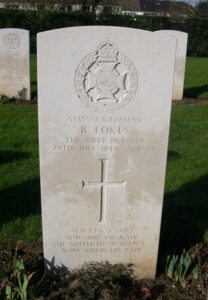
Leonard Frater, Fusilier, 14200801, Royal Inniskilling Fusiliers. Leonard was born in 1923, the son of Edward Frater and Elizabeth Frater (nee Lewis), of 51, Garden Suburbs, Trimsaran. He enlisted into the army and was posted to the 6th Battalion, Royal Inniskilling Fusiliers. The battalion was raised in October 1940, and early in 1942 joined the 210th Independent Infantry Brigade, an armoured unit. The brigade was later redesignated the 38th (Irish) Infantry Brigade, joining the 6th Armoured Division, before embarking for the Middle East to take part in Operation Torch in November 1942. The division fought in North Africa until the capitulation of the Afrika Korps in May 1943, then took part in the landings on mainland Italy. Leonard was killed by artillery fire on 29 November 1943, during an assault on a ridge overlooking the Sangro River. The 20-year-old was originally buried on the battlefield, but in April 1944 the scattered battlefield graves were exhumed and he was reinterred in Sangro River War Cemetery, Italy.
Osmond Glyndwr Guest, Rifleman, 4208565, Cameronians. Osmond was born in 1925, the son of Joseph Guest and Olwen Guest (nee Griffiths), of 82, Garden Suburbs, Trimsaran. He enlisted into the army and was posted to India to join the 1st Battalion, Cameronians. The Battalion had been in India at the start of the war, then in 1942 was deployed to Burma as part of the 1st Burma Brigade, 39th Indian Division, to take part in the campaign against the Japanese, as part of the famous Chindit force. Osmond was accidentally killed in India on 17 June 1943. The 20-year-old was buried in Kirkee War Cemetery, India.
John James Hurley, Private, 33298, Welch Regiment. John was born on 9 April 1899, the son of Johanna Hurley, of 49, Mill Street, Carmarthen. His mother, widowed some years earlier, died in 1911 and John was adopted by Ada Thompson, of 15 Mill Street Carmarthen. Following Ada’s death in 1916, John served during the Great War, and upon being discharged married Susan Booth at Llanelli in 1920. The couple then resided at 6, Morlais Terrace, Trimsaran and John gained work as a builders labourer. He was probably a member of the Territorial Army and re-enlisted into the Welch Regiment soon after the outbreak of war. He died on active service in Cheshire on 9 December 1941. The 44-year-old was buried in Chester (Overleigh) Cemetery. His wife Susan had died at Llanelli in 1940, aged 37. Henry is not commemorated on the Trimsaran War Memorial.
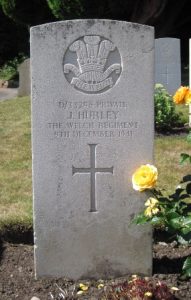
Joseph Vincent Hutchings, Captain, 184115, Somerset Light Infantry. Joseph was born on 17 April 1912, the son of William Charles Hutchings and Miriam Jane Hutchings (nee Egres), of Cloverdale, Trimsaran. He left home as a young man after becoming manager for a chain of shoe stores at Plymouth and after marrying Winifred Lilian James there in 1936, the couple set up home together at 11, Burleigh Park Road, Plymouth. Joseph gained a commission as Second Lieutenant into the Somerset Light Infantry in April 1941 and by the time that the D-Day landings were underway had risen to the rank of Captain. Sadly, he died at Hailsham, Sussex on 9 June 1944. The remains of the 32-year-old were brought home and he was buried in Sardis Independent Chapelyard, Trimsaran.
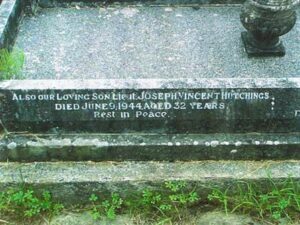
Evan Esmond James, Craftsman, 23338702, Royal Electrical and Mechanical Engineers. Evan was born at Trimsaran on 27 July 1936. He enlisted into the army and served with the Royal Electrical and Mechanical Engineers. On 1 May 1957, Evan was among around 25 service personnel and ten civilians who boarded a Vickers Viking, Serial XF629 at Blackbushe Airport, Hampshire, in order to fly to RAF Idris in Libya. The aircraft suffered an engine failure on take-off and crashed into a copse whilst attempting to land, bursting into flames. Thirty four of the 35 people on board were killed, including Evan, who was just 20 years old. His body was brought home to be buried at Trimsaran. The cause of the crash was, possibly harshly, adjudged to be the failure of the pilot to maintain a safe altitude whilst approaching to land following the failure of an engine.
Oliver Jones, Private, 3963311, Welch Regiment. Oliver was born at Llangyfelach in about 1905, the son of William Saunders Jones and Margaret Jones (nee Morgans). The family moved to 13, Arlan Morlais, Trimsaran at some time after the Great War. Oliver married Gladwen Eira Evans in 1930 and the couple settled at 129, Colby Road, Burry Port. When war broke out, Oliver was already a member of the 4th Battalion, Welch Regiment, which was the Carmarthenshire Territorial unit, attached to 158 Brigade, 53rd (Welsh) Division. The battalion was mobilised at the outbreak of war, when the Division moved to Northern Ireland to begin garrison duties. Oliver, together with a number of other men of the 4th Welch was then temporarily posted to the 108th Prisoner of War Camp at Thirkleby, to help guard the German and Italian prisoners of war interred there. Due to ever increasing numbers of prisoners, the Government came to an agreement with the Canadians to hold prisoners in Canada, so on 1 July 1940 Oliver embarked as one of the guards aboard the SS Arandora Star, which was loaded with over 1,000 Italian, German and Austrian prisoners. The ship left Liverpool later that day, steaming past the Point of Ayre, then past the Isle of Man, before passing Malin Head, heading towards Bloody Foreland and the Atlantic. Tragically at around 07.00 on 2 July 1940, the Arandora Star was torpedoed by the German U-boat U-47, and sank with the loss of over 800 lives, including prisoners, guards and crew. Oliver was 36 years old when he drowned in the sinking of Arandora Star that day. He has no known grave, so is commemorated on the Brookwood Memorial, Surrey.
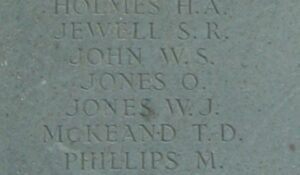
William John Lloyd, Able Seaman, C/JX 198531, Royal Navy. William was born at St. Clears on 15 February 1917, the son of Richard James Lloyd and Elisabeth Lloyd (nee Griffiths). The family came to live at 52, Garden Suburbs, Trimsaran at some time afterwards. William married Iris Gwyneth Evans, of Tumble, in 1939. He worked as a contractor’s labourer prior to enlisting into the Royal Navy and after completing his training was posted aboard the WW1 era Ceres group c-class light cruiser, HMS Curacoa. The ship had been in reserve and was then used as a training ship prior to being refitted and converted into an anti-aircraft cruiser just after the outbreak of war. In January 1940 the ship was assigned to the Home Fleet, then took part in the ill-fated Norwegian Campaign, escorting a British troop convoy to Åndalsnes and then landed a battalion of the Sherwood Foresters at Molde. She returned to Britain, but was ordered back to Åndalsnes to protect the beachhead from German aircraft, and was damaged by a German bomb soon afterwards, which forced her to return home for repairs. Curacoa was then assigned to the Western Approaches and began convoy escort duties. On the morning of 2 October 1942, Curacoa rendezvoused north of Ireland with the ocean liner Queen Mary, which was packed with 10,000 American Troops. Queen Mary was following the standard pattern of zig-zagging, to help prevent against torpedo strikes, when Curacao cut across her bow. Queen Mary struck the destroyer amidships, sending her to the bottom in six minutes, with the loss of over 200 men. William was 25 years old when he died that day, on 2 October 1942, and is commemorated on the Chatham Naval Memorial, Kent.
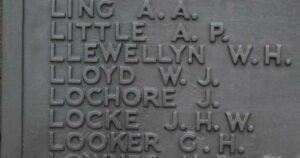
Alun Rees, Sergeant, 1316996, Royal Air Force Volunteer Reserve. Alun was the son of Thomas John Rees and Lily Rees (nee Lloyd), of Bryn Cottage, Trimsaran. He enlisted into the Royal Air Force Volunteer Reserve and after qualifying as an Air Gunner at 1660 Operational Training Unit, was posted to 9 Squadron, Royal Air Force, which was a heavy bomber squadron, based at RAF Waddington, equipped with the Avro Lancaster I. On the night of 13 January 1943, Alun and his crew took off from Waddington on their first operational flight, aboard an Avro Lancaster I, Serial W4843, which joined a large bomber group despatched to strike targets in Essen. At around 21.00 that night their Lancaster was intercepted and shot down by a German night fighter, crashing into the sea West of Schouwen-Duiveland Island, Zeeland, with the loss of all seven of her crew. Alun was just 19 years old when he was killed that night. He has no known grave, so is commemorated on the Runnymede Memorial, Surrey.
Robert Charles Santley, Flight Sergeant, 566738, Royal Air Force. Robert was born in 1917, the son of Charles Winton Santley and Eleanor Santley (nee Mayoh), of 93, Garden Suburbs, Trimsaran. He enlisted into the Royal Air Force and after gaining his pilots wings was posted to 253 Squadron, Royal Air Force. On 30 October 1939, the Squadron reformed at Manston, and became equipped with Hurricanes in February 1940, becoming operational on 3 April. In May 1940 one flight was sent to France to reinforce the hard-pressed Hurricane squadrons while the second flight flew daily to French airfields during May. After re-equipping in Lincolnshire, 253 Squadron took part in the Battle of Britain, and remained in southern England until January 1941. In February the squadron moved to the Orkneys for air defence duties, returning to England in September for convoy patrols off the East Coast. Robert married Florence Elizabeth Grace Melling, of Conwy, an A.T.S. Officer, at Liverpool in March 1942. He was killed on 27 August 1942 whilst flying a Hawker Hurricane IIC, when it crashed Into the sea off Mablethorpe, Lincolnshire during a training flight. The body of the 24-year-old was not recovered from the sea, so he is commemorated on the Runnymede Memorial, Surrey. His widow remarried to Peter Martin in 1948.
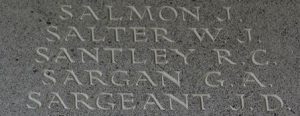
Bernard William Susans, Fusilier, 3970325, Royal Welch Fusiliers. Bernard was born in Sheerness in 1924, the son of Bertram Susans and Valentine Ada Beatrice Susans (nee Plumb). The family had moved to Kidwelly in the years prior to the war, as his father had gained a position as a civilian armaments instructor at RAF Pembrey, and had settled at 10, West Hill Crescent, Station Road, Kidwelly. Bernard enlisted into the army following the outbreak of war and enlisted into the 1st Battalion, Royal Welch Fusiliers. The battalion had been decimated at St Venant during the retreat to Dunkirk in May 1940, whilst holding up two German Panzer Divisions. The battalion reformed in Britain, before joining the 2nd Division, and moving to the Far East in 1942, taking part in the defence of India, and then taking the fight to the Japanese in the jungles of Burma. Bernard was killed during the Battle of Kohima on 28 May 1944, one of the bloodiest engagements of the entire war, also known as the ‘Stalingrad of the East’. The 21-year-old has no known grave and is commemorated on the Rangoon Memorial, Myanmar.
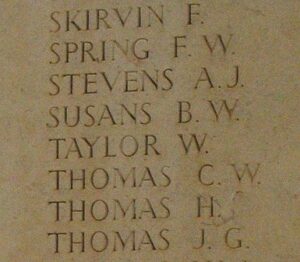
Rees Owen Thomas, Private, 3971772, Welch Regiment. Rees was born on 7 February 1916, the son of William Thomas and Margaretta Thomas (nee Howell), of Waunhir, Trimsaran. He worked as a general labourer prior to enlisting into the Welch Regiment, and was drafted to India to join the 2nd Battalion, Welch Regiment. The battalion had been stationed at Agra in India when war broke out, and was on garrison duties, with the men awaiting news of being posted to an active theatre of war. Rees died as a result of an accident whilst on active service in India on 30 April 1941, so never got to see action. The 28-year-old was buried in Kirkee War Cemetery, India.
Evan Gethin John Williams, Greaser, Merchant Navy. Evan was born on 3 December 1925, the son of William Williams and Elizabeth Williams (nee Evans), of 174, Garden Suburbs, Trimsaran. He enlisted into the Merchant Navy and served as a Greaser aboard the London registered cargo ship, MV Tower Grange. In 1942 Tower Grange sailed from Calcutta bound for Trinidad and then Britain carrying a mixed cargo, including manganese ore. She called at Cape Town on 27 October before heading into the Western Atlantic. During the morning of 17 November the German submarine U-154 spotted her, but Tower Grange steered a zigzag course that prevented attack. During the early hours of the following morning, 18 November 1942, Tower Grange managed to evade a torpedo attack by the U-Boat, but soon afterwards was hit by a second attack and sank with the loss of six lives. The majority of the crew, including a number of DEMS Gunners, managed to take to the lifeboats and were later rescued, but sadly Evan was killed during the torpedo strike that day. The 16-year-old has no known grave and is commemorated on the Tower Hill Memorial, London.
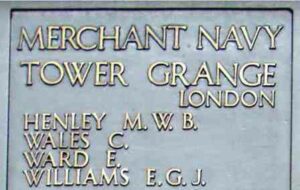
Ivor Verdon Willyeo, Sapper, 2074896, Royal Engineers. Ivor was born in 1916, the son of James Edwin Willyeo and Lavinia Willyeo (nee Curtis), of Skewen. He married Phyllis Gwenllian Calford, of Brynawel, Trimsaran, in 1940. Ivor enlisted into the army and trained as a bomb disposal expert before being posted to 10 Bomb Disposal Company, Royal Engineers, which was based at Manchester. Little else is known of Ivor, but he was killed in action at Barrow-in-Furness on 10 March 1944, probably whilst carrying out bomb disposal work. The remains of the 27-year-old were conveyed home and he was buried in St. John’s Churchyard, Skewen. His widow, Phyllis, sadly died in 1946, also aged 27. Ivor is not named on the Trimsaran Memorial.
